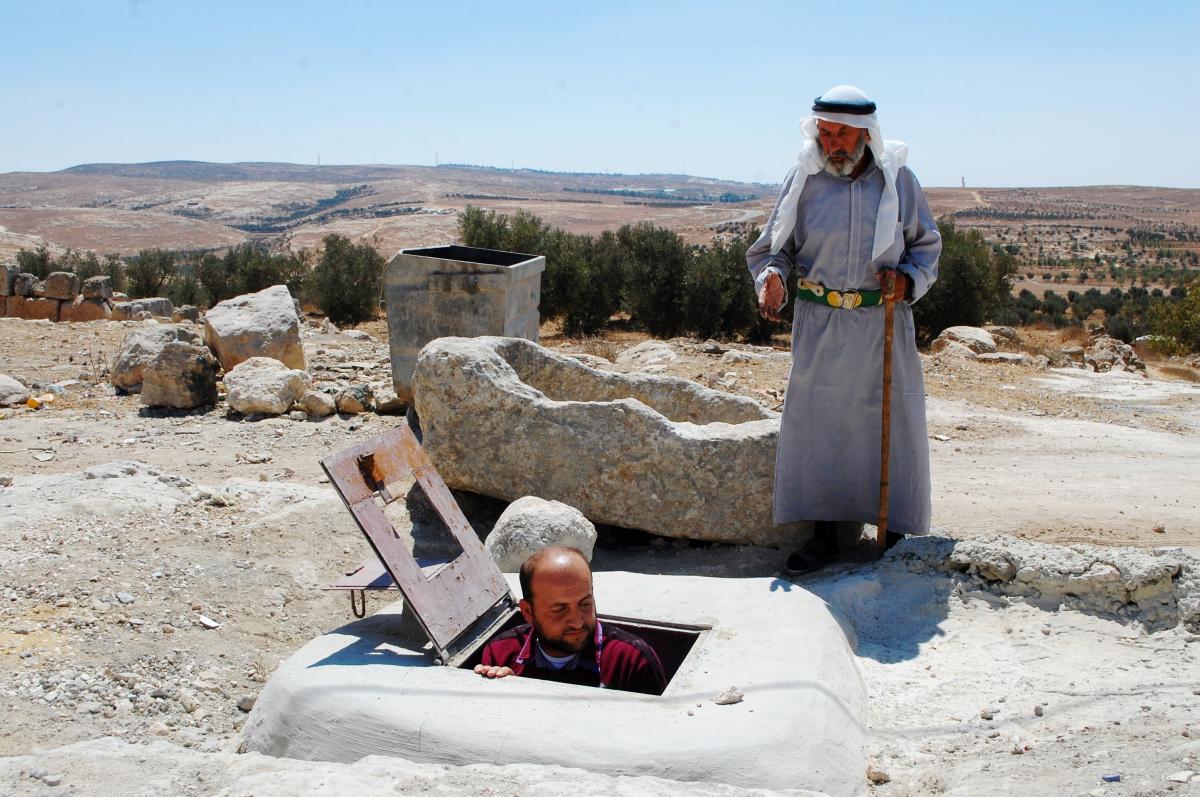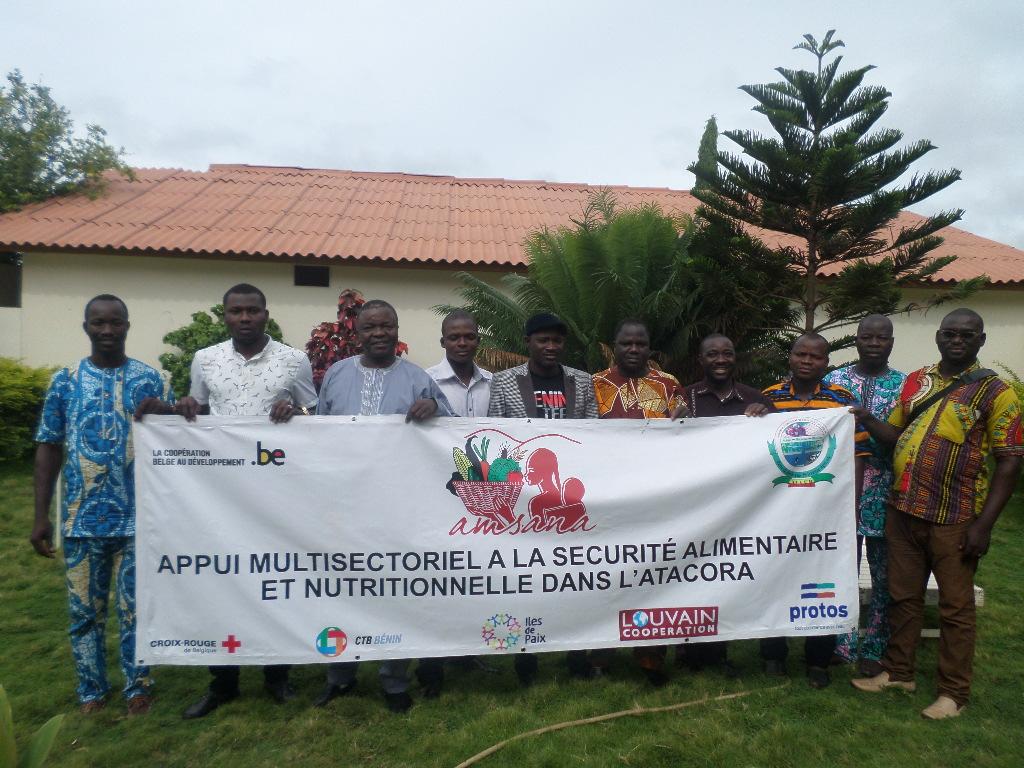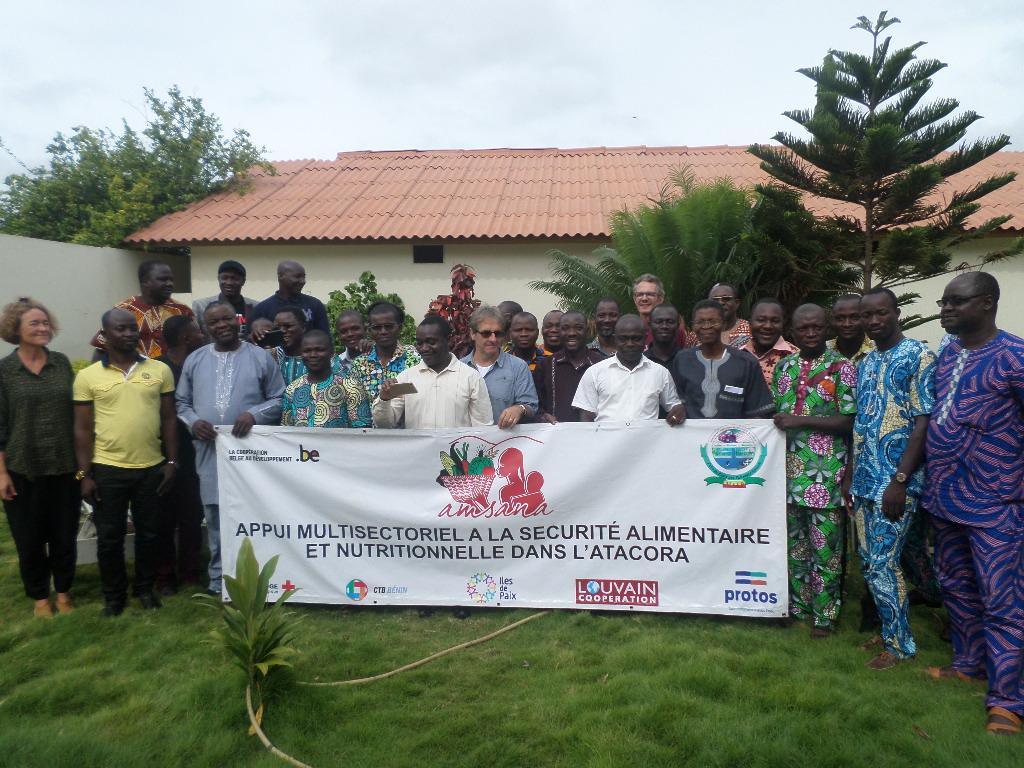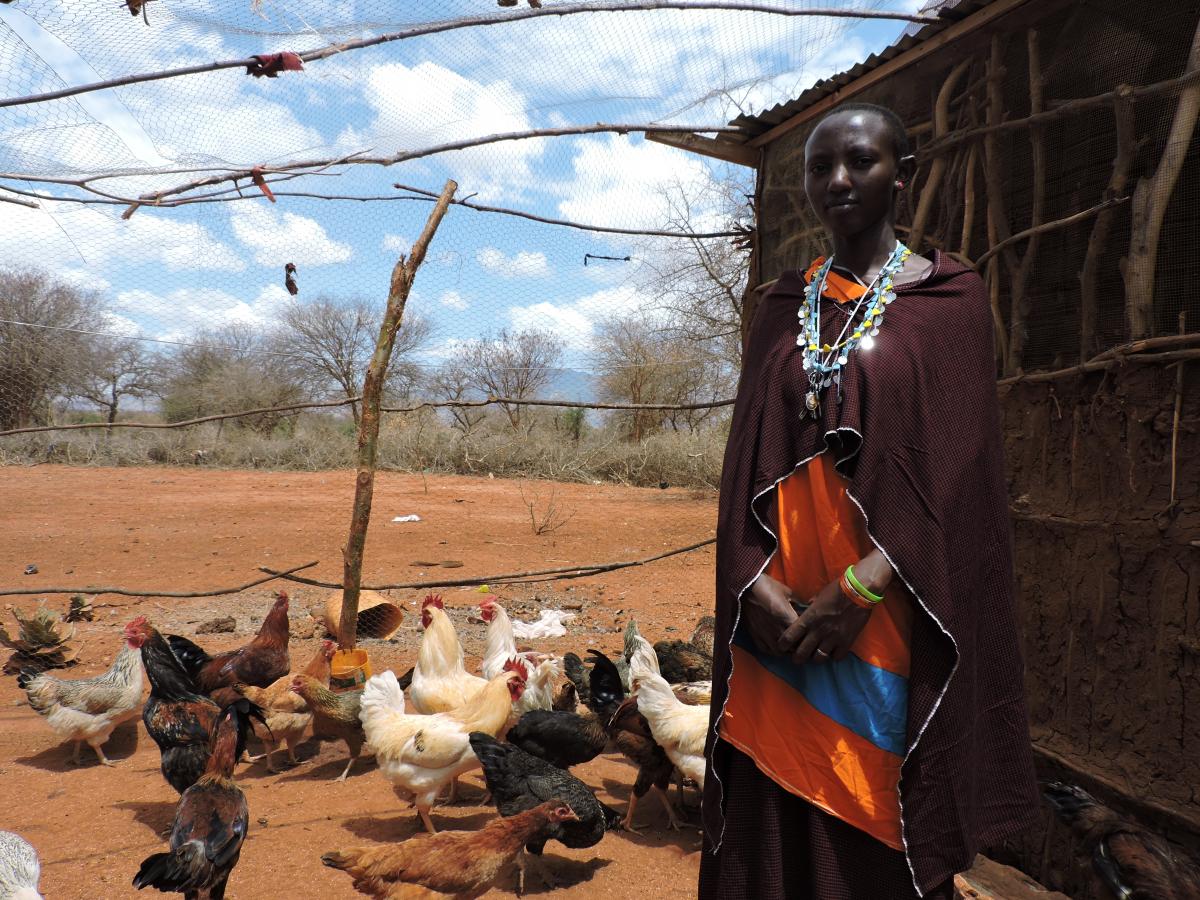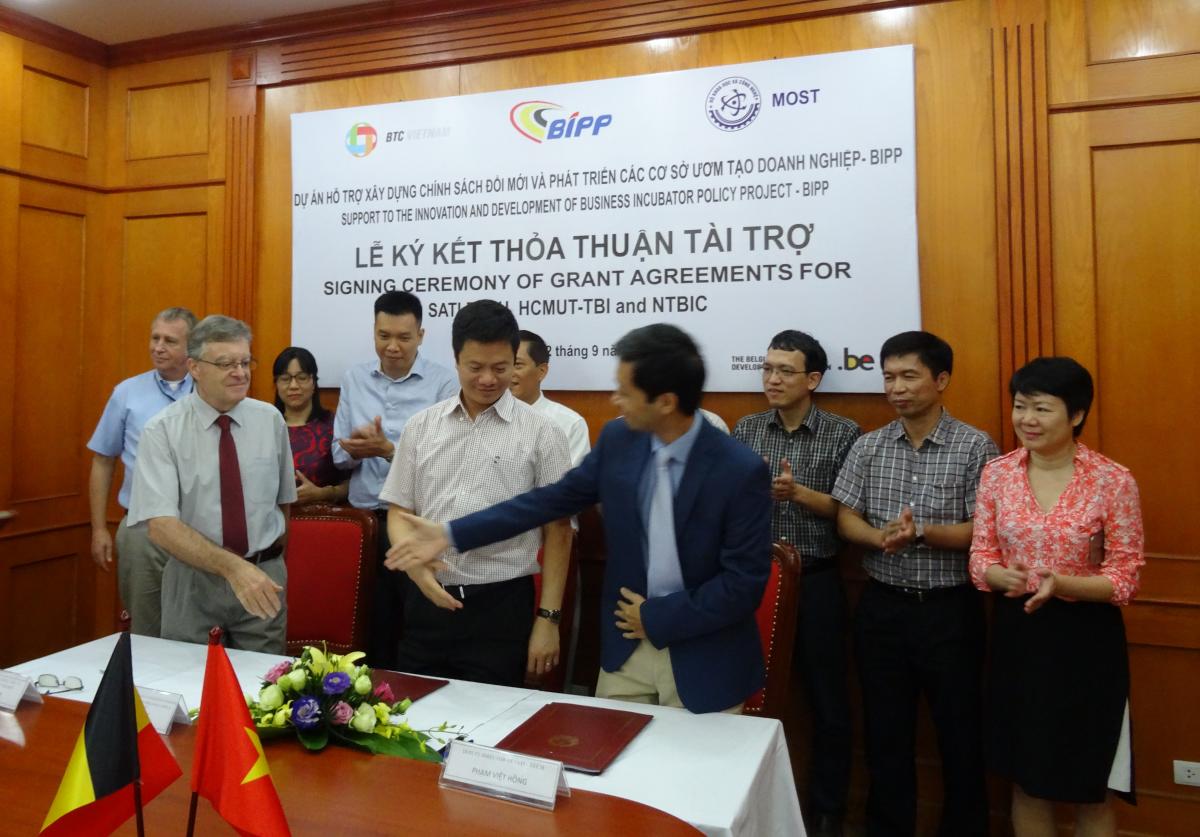Opzoeken
2355 - 2370 van 2520 nieuws bekijken
-
Local Economic Development (LED) - A new pillar to strengthen collaboration between villages
Eva MORRE | 13/10/2016
Currently, the West Bank is split in more than 500 local government units. Some of them are so small that they are not able to provide the necessary services to their citizens in terms of waste management, water supply, street cleaning… The Local Government Reform and Development Programme (LGRDP) tries to strengthen municipalities and village councils across the West Bank in order to give everyone access to basic services, also the citizens living in the smallest villages. The intention is to create a streamlined local government sector with an effective local administration capable of realising sustainable development, and to reduce the development discrepancies between communities. Therefore, we aim to facilitate and strengthen inter-village collaboration, so that villages can exploit and share local resources and jointly provide the necessary services for their citizens. In order to encourage small villages to work together, we are now implementing a local economic development (LED) approach. A LED strategy can offer a small window of hope for the future of the Palestinian population notwithstanding the great uncertainty about the creation of a viable Palestinian State in the coming decades. It helps the Palestinians to improve their local economy, which should lower the unemployment and increase social cohesion and will eventually contribute to the enhancement of their quality of life. The first LED pilot project under the local government reform and development program started one year ago, in the newly created municipality of Al Karmil, consisting of four villages that have decided to melt together. The socio-economic analysis of Al Karmil revealed that the cluster has four sectors of high economic potential. The most important of them is the agricultural sector. Although the agricultural sector in Al Karmil could potentially have been very developed already, it was suffering from a severe lack of water. Therefore, the LED strategy for Al Karmil has focused mainly on improving the access to water for the local farmers. In total, 35 water cisterns have been rehabilitated, so the farmers can again collect rainwater for agricultural purposes. Moreover, 40 farmers have been trained on water management skills and best water practice awareness, in order to maximise the use of the available rainwater. The water cisterns have been rehabilitated by local farmers, who operated as small contractors for the project. By employing locals, the ownership of the project in the local community has increased. Furthermore, this opportunity created 80 temporary working opportunities for community members. In the future the LED strategy will be developed and used in other village-clusters as well. Depending on the existing local resources of each village-cluster, the approach will be different for each of them, but in every cluster the LED strategy will always be developed in partnership with the private, public and civil society sectors.
-
Matéri, Tanguiéta, Cobly : trois communes, un même combat contre la malnutrition
Bellya SEKPON | 10/10/2016
Résumé des interviews de Monsieur Paul Sahgui, maire de la commune de Tanguiéta (assisté par le Chef Service Planification et Développement Local de la commune, Monsieur Feysal Pogo), du 2ième adjoint au Maire de Cobly, Monsieur Yves Kaucley et de Monsieur Sorikoua Sambiéni, Maire de la commune de Matéri.La malnutrition, un problème global dans les communes de Matéri, Tanguiéta et CoblySelon les personnes interviewées, la malnutrition est un problème général dans les trois communes de Matéri, Tanguiéta et Cobly. Son taux varie entre 30% et 44%, selon les mairies concernées. Ce sont surtout les zones rurales qui sont les plus touchées, les zones urbaines étant plus ou moins préservées. Dans les zones rurales, les effets de la malnutrition sont criants et décelables à l’œil nu chez les enfants de 0 à 5 ans. Plusieurs causes sont relevées par les responsables des communes pour expliquer la malnutrition dans leurs localités. A Matéri, par exemple, le Maire insiste sur le fait que « malgré la disponibilité des produits riches en protéines et autres nutriments indispensables à une bonne santé, les populations continuent de faire face à la malnutrition parce qu’elles ne se nourrissent pas selon les normes alimentaires. C’est plus une question de prise de conscience et d’habitude alimentaire au fil des générations qui fait que cet état de choses perdure ». Monsieur Sambiéni insiste aussi sur les habitudes sanitaires qui ne sont pas adaptées pour favoriser une bonne nutrition. Ainsi, les populations se rendent à l’hôpital uniquement quand elles sont malades et ne procèdent à aucun déparasitage ou autre suivi sanitaire de prévention. Pour le Maire de Tanguiéta et son collaborateur, leur commune fait face à un grave problème de malnutrition du fait de l’indisponibilité de terres cultivables dans certaines de leurs localités : « Quand on prend le village de Tanongou et Cotiakou où le relief est rude, montagneux et très accidenté, il n’y a pas suffisamment de terres cultivables et le problème de malnutrition s’y pose en terme de disponibilité et en termes d’accessibilité. » affirment – ils. Les Maires de Tanguiéta, Matéri, et Cobly expliquent aussi la malnutrition dans leurs communes par le fait que « les parents, lorsqu’ils produisent, bradent les produits au lieu de les utiliser pour nourrir leur famille et particulièrement les enfants ». Dans sa démarche pour faire face à ce dernier facteur déterminant Monsieur le Maire de Tanguiéta est entrain de prendre des mesures pour « sensibiliser les populations sur le fait qu’à la production, il y a une part qui doit être réservée pour la vente et l’autre, la plus grande partie, pour la consommation et doit suffire pour toute l’année. »Mais de l’avis général, un autre facteur, insoupçonnable et pourtant bien réel, affecte directement ou indirectement, la nutrition chez les petits et les adultes dans les communes de Matéri, Cobly et Tanguiéta. Il s’agit de l’alcoolisme. L’alcoolisme, facteur favorisant la malnutrition chez les enfants et les adultesPour étayer cette affirmation des autorités interviewées, le 2ième adjoint au maire de Cobly, monsieur Yves Kaucley, évoque l’étude réalisée par le directeur de l’Hôpital Saint Jean de Dieu de Tanguiéta, dans laquelle ce dernier tire la sonnette d’alarme en estimant que si rien n’est fait d’ici 10 ans, la jeunesse des trois municipalités sera détruite par l’alcool et donc incapable de contribuer à la production agricole locale. Monsieur Kaucley s’appuie également sur des mémoires d’étudiants portant sur l’alcool et ses effets négatifs dans les communes concernées. Pour lui « chez les adultes, la malnutrition est liée à la consommation d’alcool frelaté dans nos régions, surtout le SODABI que les femmes fabriquent sur place et dont on ne sait avec quel produit il est fabriqué. La population en consomme beaucoup. On peut parler de malnutrition parce que la personne qui s’adonne à ces boissons n’arrive plus à manger correctement et investit tout son argent dans l’achat de boissons alcoolisées frelatées ».Monsieur Sambiéni, Maire de Matéri, insiste quant à lui sur l’impact de ces boissons sur les enfants : « Vous verrez par exemple une dame censée préparer à manger et qui n’arrive pas à le faire, à cause de la consommation excessive d’alcool. Ce qui fait que les enfants ne mangent pas à temps ou pas du tout, parce que leur mère est saoule. Ou vous pouvez voir le père qui vend une partie de ses récoltes pour prendre de l’alcool, ce qui fait que la famille se retrouve sans aliments ».Monsieur Yves Kaucley décrit la situation comme très alarmante et préjudiciable à la lutte contre la malnutrition dans les communes de Matéri, Tanguiéta et Cobly : « Aujourd’hui, si on n’arrête pas ce phénomène de consommation excessive d’alcool frelaté, on aura la volonté de promouvoir la sécurité alimentaire mais on n’aura même plus de bras valides pour intervenir dans les champs afin que la production soit massive ».Face à cette menace, les Maires des trois communes ont décidé mutualiser leurs efforts pour lutter contre ce fléau, car, en allant en rangs dispersés, ils se retrouvent confrontés à de nombreuses difficultés, comme le souligne le 2ième adjoint au maire de Cobly : « On a vraiment à cœur ce problème. Mais face à certains paramètres, chaque Maire pris séparément se retrouve dans l’incapacité d’arrêter ce fléau. Nous nous sommes joints aux Maires de Matéri et de Tanguiéta pour mener la lutte ensemble. Parce qu’aujourd’hui, ces dames [fabricantes de boissons frelatées] ont des maisons dans la localité mais personne n’a accès à ces maisons. Et au jour le jour, elles continuent de produire ces boissons ».Le Programme AMSANA, un programme de qualité pour lequel tous les Maires sont engagésPour le Maire de Matéri, AMSANA leur a permis de « prendre conscience du fait que la sécurité alimentaire et nutritionnelle est une question importante, de l’intégrer dans notre jargon et dans nos politiques. ». Le maire de Tanguiéta souligne aussi comme force du programme le fait que « AMSANA a choisi comme porte d’entrée la commune. Donc tout passe par la commune qui doit jouer un rôle de coordination et de suivi des activités sur le terrain ». Quant au 2ième adjoint au maire de Cobly, il estime que « si ce que déclare AMSANA sur le plan théorique, le programme le met effectivement en pratique, il ne faudra même pas attendre la fin des quatre ans d’exécution pour obtenir des résultats concrets ».Les Maires démontrent donc un grand intérêt pour le Programme auquel ils ont été associés dès les premières phases. Et pour l’accompagner, ils se disent prêts à intégrer la Sécurité Alimentaire et Nutritionnelle dans les prochains Plans de Développement Communaux (PDC). Ils sont conscients qu’il y va d’abord et avant tout de l’intérêt de leurs administrés, des populations dont ils ont la charge. Comme le dit si bien le Maire de Matéri, qui résume l’avis général des Maires impliqués dans le Programme AMSANA, « notre rôle c’est d’abord de prendre en compte les aspects de la Sécurité Alimentaire et Nutritionnelle dans nos politiques et documents de planification et d’accorder les ressources qu’il faut pour mener à bien cela. Car le rôle de la mairie n’est pas juste de construire des infrastructures mais aussi de faire en sorte que la population mange à sa faim et qu’elle puisse améliorer ses revenus pour réaliser le développement ».Il ne reste donc plus qu’à formuler, comme le Maire de Tanguiéta, le vœu que « tous les acteurs impliqués dans la mise en œuvre du programme réalisent le rôle central de la Mairie dans le programme, pour que d’ici 20 ans, le relai soit vraiment assuré. Parce que nous parlons de pérennisation des acquis. C’est vrai que le programme n’est là que pour cinq ans, mais la commune, elle est toujours là ».
-
Atelier d’appropriation du programme Appui Multisectoriel à la Sécurité Alimentaire et Nutritionnelle dans l’Atacora (AMSANA)
Bellya SEKPON | 10/10/2016
Les 12 et 13 juillet 2016, les acteurs impliqués dans la mise en œuvre du Programme Appui Multisectoriel à la Sécurité Alimentaire et Nutritionnelle dans l’Atacora (AMSANA) se sont retrouvés en conclave à Parakou. Le but de la rencontre était d’amener les parties prenantes du programme à dégager une compréhension harmonisée du concept de sécurité alimentaire, de la logique d’intervention du programme, et de leurs rôles de façon à ce qu’ils contribuent tous d’une manière efficiente à l’atteinte des résultats et au suivi du programme. Rappelons qu’AMSANA est un Programme multi-acteurs d’un montant de 12 592 080 d’euros financé par le Fonds Belge pour la Sécurité Alimentaire (FBSA), qui a pour objectif d’améliorer la sécurité alimentaire et nutritionnelle des groupes vulnérables des Communes de Boukoumbé, Cobly, Matéri et Tanguiéta. Il est mis en œuvre par un consortium de Cinq (05) acteurs belges que sont Iles de Paix, Louvain Coopération pour le Développement, la Croix Rouge de Belgique, Protos et la CTB avec chacune, une valeur ajoutée spécifique.Animée par la consultante Hannelore Beerlandt, venue de Belgique pour la cause, cette rencontre a connu la présence de cadres des services techniques des mairies impliqués dans la mise en œuvre du projet, de cadres du Ministère de l’Agriculture de l’Elevage et de la Pêche (MAEP) et du Centre d’Action Régional pour le Développement Rural (CARDER), des équipes des différentes institutions associées mais aussi des maires des communes de Tanguieta, Matéri et du 2ème adjoint au maire de Cobly.
-

Beekeeping films on Youtube
Jennifer SWERTVAEGHER | 07/10/2016
The strategy of the Beekeeping Support Project in Kigoma Region (2012-2016) was to develop the honey value chain, while linking this to sustainable management of natural resources and institutional capacity building. Over 5000 beekeepers and their families were reached, as well as processors’ groups, cooperatives, traders and exporters operating in Kigoma Region. At the end of the project, 3 films were produced, each serving a particular purpose: 1. To promote the sale of honey from Kigoma region, a short film was made to highlight the main reasons why consumers should buy Kigoma honey: organic by defaulthigh quality processingconservation by sustainable use of natural resourcessupport to local economic development and livelihoods2. To increase production, the use of modern beehives and beekeeping techniques were promoted. A second video zooms in on one of these techniques: bee queen rearing. The film advocates the opportunities and adoption of queen rearing in Tanzania. Because more bee queens, means more bee colonies; and more colonies, means more honey!3. The last film is a visual report of the main project activities and achievements. These were aimed at:improving beekeepers’ incomes through improved production and business skillsimproving the efficiency of honey value chains through coordination and capacity building to respond to market opportunitiesprotecting key forest and bee forage areascreating an enabling environment for sustainable beekeeping local and national levelWatch the films now!1. https://www.youtube.com/watch?v=Mim4xCLiGZc2. https://www.youtube.com/watch?v=IInw5pZN71k3. https://www.youtube.com/watch?v=S6VocJEkvHU
-
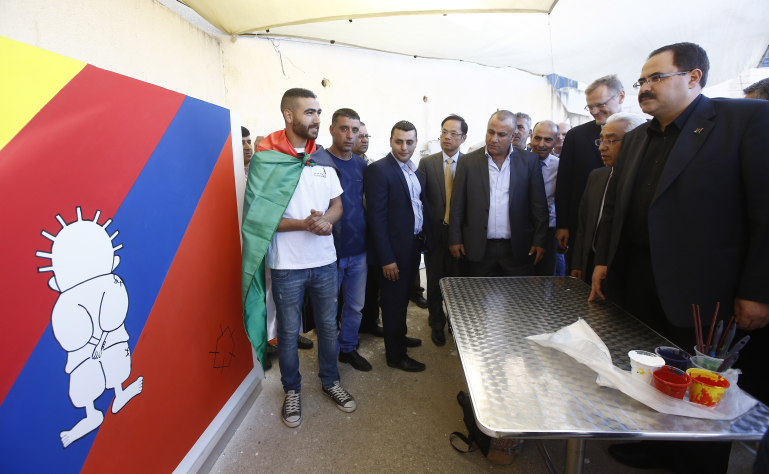
First National ‘PalestineSkills’ Competition
Eva MORRE | 06/10/2016
On the 4th of October the final of the first National ‘PalestineSkills’ Competition took place in Ramallah. Young craftsmen and women were encouraged to take part in this competition and show their skills to the public in an effort to promote technical and vocational education and training (TVET) in the Palestinian Territory.Young people from a wide range of crafts took part in the competition, which started more than 2 months ago. In a first stage more than 250 people subscribed, out of which 20 people were pre-selected for each vocation. In the second phase, they had to conduct a practical test in three different TVET institutions, depending on their craft: the tiling and painting in Jenin, graphic design in Hebron and pastry in Bethlehem. A professional jury consisting of members of the chambers the private sector and TVET teachers, selected the five best craftsmen and women from each skill. These five people were given the opportunity to attend a two-day capacity building workshop. Afterwards, for the last stage, they were invited to compete at the finals of the 1st PalestineSkills National Competition in Ramallah. The event was a joint initiative of the Ministry of Education and Higher Education, the Ministry of Labour and the the Federation of Palestinian Chambers of Commerce, Industry and Agriculture (FPCCIA). The event was supported by GIZ and the Belgian Development Agency. During the finals, the three best craftsmen in tiling, painting, graphic design or confectionary were selected. They will now be prepared for participation in the next international WorldSkills Competition held in Abu Dhabi in October 2017. We wish them good luck! More information: https://www.facebook.com/palestineskills
-
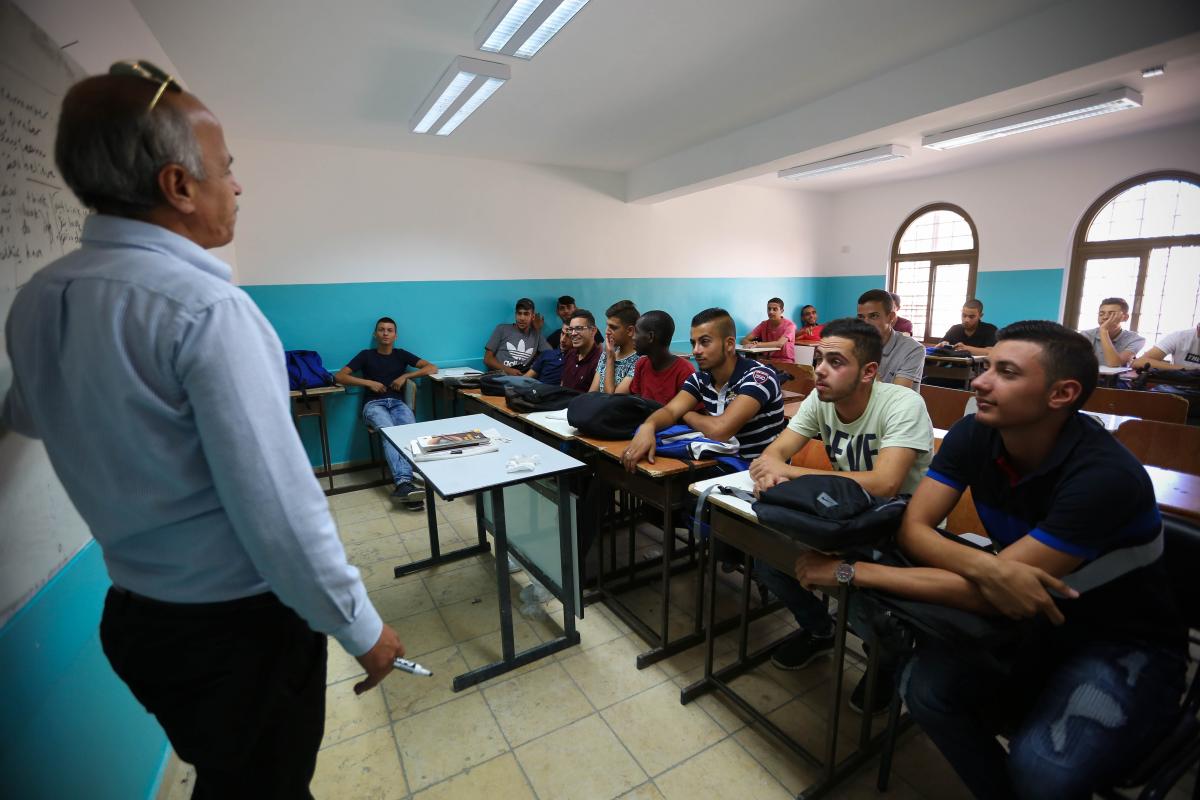
Work in Progress: School Renovation in East-Jerusalem
Eva MORRE | 05/10/2016
Shortly after the 1967 war, Israel annexed East Jerusalem and included it within the municipal boundary of Jerusalem. Although this move has not been recognized by the international community or the Palestinians, it has wide-spread consequences for daily life in the area. In East Jerusalem there is an immense shortage of adequate school buildings. An estimated additional 1,000 classrooms are needed to accommodate the growing number of students. In order to construct new buildings, the Palestinian Authority needs a building permit, issued by the Israeli government. The process to obtain such a permit is very lengthy; most of the time the permits are denied. That is why many schools find refuge in rented houses or apartment buildings. But these are not purpose-built schools, and they often do not meet basic educational and health standards. They do not have integrated classrooms, teachers' rooms, libraries or laboratories, nor do they have playgrounds. More importantly, many of these schools have inadequate toilet facilities. The Belgian development cooperation has been active in the education sector since 2001. Within the school construction programme, 1.3 million euro was set aside specifically for the renovation of school buildings in East Jerusalem. In order to identify the needs and to prioritize interventions, the programme conducted the so-called Equivalent Student Sufferings (ESS) Survey through local consultants. This survey rates the school according to different indicators, such as the suitability of classrooms and labs, hygiene and sanitation, accessibility, safety and security. In total 120 school were visited and the findings provided BTC and other donors with technical and financial information on how to rehabilitate the 30 ‘most suffering’ schools. Not enough budget was available to finance all 30 of them at once, but thanks to the support of BTC nine schools have already been renovated this summer. In a second phase nine more schools will be renovated with an additional budget of 1 million euro. The renovation works that took place this summer included electric wiring, new furniture, ventilation systems, classroom refurbishings, fire safety systems, toilets and facilities for handicapped people. The works have taken place in 9 schools with a total of more than 3000 students, from the age of kindergarten until 12th grade.
-
Focus on livestock: Chickens help Maasai to combat food insecurity.
Toon DRIESEN | 04/10/2016
Together with Heifer International, Veterinarians without Borders (VSF) introduced chickens to improve the food security of Maasai households in Longido and Simanjiro district in Tanzania. Chickens play a crucial role in protecting children from hunger and malnutrition, especially during the dry season. For Maasai families, chickens are more than just a source of protein. Through the sales of eggs they also provide income. VSF and Heifer International trained the women to build a chicken shed, to take care of the chickens, and to recognize and treat pests and diseases. Each Maasai village received the materials to build a chicken shed, 5 vaccinated cocks and 30 vaccinated pullets. Once they produce offspring, the women share the chicks among each other. In doing so, each woman will eventually have her own chickens to help getting nutritious food and income for her family. Nedaudi Theresia is one of the women who received chickens through the Maisha Bora programme: “Thanks to the advice of VSF we are now selling a lot of eggs and chickens and we use this to pay school fees and medicines. We’re also using the eggs and the meat for food for our children.” You can read the full article on the website of Veterinarians Without Borders:Dutch: http://www.dierenartsenzondergrenzen.be/nl/nieuws/item/6039-kippen-helpen-de-masai-de-honger-overwinnen# French: http://www.veterinairessansfrontieres.be/fr/actualite/item/6037-des-poules-pour-lutter-contre-la-faim-chez-les-masai
-
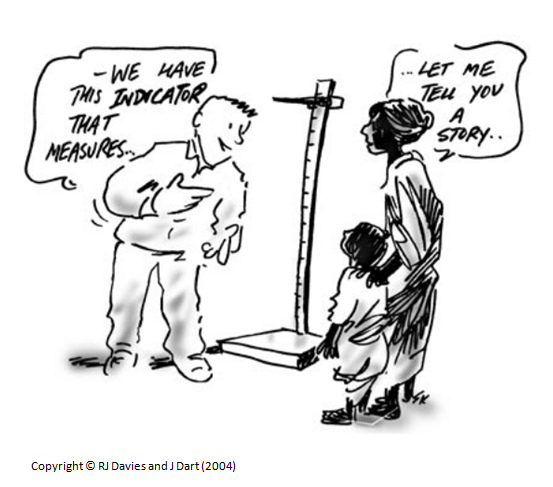
Focus on coordination: workshop on narrative storytelling videos
Toon DRIESEN | 04/10/2016
What graphs and tables can't tell you.Using narrative storytelling videos in development programmes.How could we integrate qualitative and contextualized information into our development programmes to enrich our monitoring, evaluation and learning processes? BTC invited Tian Cai from Michigan State University to Arusha for an interactive workshop on narrative storytelling videos for development programmes.'hard' data counts In times of results-based management and a push towards accountability, development agencies have been showing a preference for quantifiable indicators and ‘hard’ data to demonstrate the impact of development programmes worldwide. Qualitative or more contextualized information, yet providing rich and relevant information, are often considered to be expensive, time-consuming and difficult to handle.… but listen to the storiesSo, why should we be interested in stories? Tian Cai, academic researcher and storytelling expert explains: “Stories balance logical and emotional dimensions of human thinking. They give us context and background information and people use it to make sense of the real world. Pre-defined surveys provide us solid evidence about what happens in a community, but stories can show us how and why change happens.” Tian argues for an integrated approach where surveys and quantifiable data are complemented with rich stories. Tian: “The stories allow you to contextualize your survey data and tell you what’s behind the graphs and tables.”technologyThe technological and digital developments of the last 10 years radically changed the way development programmes and projects are being monitored and evaluated. Mobile phones, tablets and GIS software have come to the fore, making new, more and richer data available for monitoring, evaluation and learning. According to Tian, the same technological revolution urges us to re-evaluate the shabby treatment of qualitative information in development programmes. “In recent years, technologies have become much more accessible to a wide range of development organisations. Even with a very simple camera or smartphone, you’re able to capture video stories. And with a portable pico-projector screening of videos is now possible in almost any rural or remote setting.”a tool for development In her academic research Tian investigates the use of narrative storytelling videos in development programmes in Kenya and Malawi. Tian uses videos for training local communities, for external communication about development programmes and as an alternative way of monitoring, evaluation and learning. Depending on the use of the videos, she uses both testimonies and storylines styles. Tian: “Peoples’ testimonies are relatively simple to shoot with less editing work, while the storyline style include rich information about the socio-cultural context.” During the workshop in Arusha, Tian illustrated the different steps in creating storytelling videos. “The first thing you need to know is what topics you are looking for or which questions you want to answer. Then you need to listen to the stories that are out there. Which stories are mentioned many times or which unique stories represent the community, a certain programme or the diversity or complexity of a development problem?”and…action! At the end of the workshop Tian invited all participants to prepare and design their own storytelling videos. Based on personal stories from their professional experience, the participants developed their own storyboard, a brief planning and description of the different scenes of the story. “The storyboard briefly outlines the different messages you want to include in the video, but it should not be too detailed as you want the people themselves to tell the story from their perspective.”So, after a short but intensive one day workshop our participants left with a storyboard of what could become their first storytelling video. We definitely got inspired about the potential value of storytelling and many participants got triggered to integrate it into their programmes and projects. As one participant explains: “I realized that integrating narrative storytelling videos in our programme is really feasible and doesn’t necessarily need to be time-consuming or expensive. We made our own storyboard now, so basically we only need a camera and a microphone and we can start shooting our video.”
-
Three grant agreements signed for science & technology incubators in Vietnam
Huong TRANTHANH | 03/10/2016
The signing on 22 September 2016 of the Grant Agreements is a milestone facilitating Belgian financial support to three key project stakeholders in the Science & Technology incubation sector in Vietnam. The following institutions are receiving a financial grant:Designing, Pilot Manufacturing and Testing Center (SATI-TECH), represented by Mr. Pham Viet Hong, receiving €495,000 to implement the InnoFund for further acceleration of entrepreneurial science and technology innovation and support structures;Technology Business Incubator Center - National Center for Technological Progress (NTBIC), represented by Mr.Tran Vu Tuan Phan, receiving €170,000 to implement S&T entrepreneurial incubation activities in Hanoi;Technology Business Incubation Center - Ho Chi Minh City University of Technology (HCMUT-TBI), represented by Mr. Mai Thanh Phong, receiving €100,000 to implement S&T entrepreneurial incubation activities in Ho Chi Minh City. The signing of the Grant Agreements with the three institutions was conducted by Mr Alain Devaux, resident representative of the Belgian Development Cooperation (BTC) in Vietnam, and Mr Tran Dac Hien, BIPP Project Director representing the Ministry of Science and Technology.The signing ceremony was attended by the honorable Vice Minister Tran Van Tung – Ministry of Science and Technology. In his speech he highlighted that S&T enterprises are playing an important role in the development of Vietnam. Last year, 87 new S&T enterprises were established, and 160 applications were reviewed for certification. S&T enterprises do not only convert applied science into practical reality and production, but also create products with high added value. According to the national science development strategy approved by the Prime Minister, Vietnam is aiming to establish approximately 5,000 S&T enterprises by 2020. The Vice Minister strongly believes that, with the support from Belgium, Vietnamese S&T entrepreneurs have better opportunities to finalize their prototypes and capture existing market potential. Through the grants he expects scientists and entrepreneurs to further incubate their scientific innovation and bring promising ideas to the market. In the near future, Vietnam will possess more high-tech brands. This will not be simple, but the Vietnamese Government jointly with the private sector will do their best to achieve this noble objective. The Vice Minister concluded that enthusiasm for science and technology is fostered in the public and will mobilize more creative resources for the modernization of Vietnam.Mr. Alain Devaux, resident representative of the Belgian Development Cooperation (BTC), thanked the honorable Vice Minister Tran Van Tung for his full-hearted project support and wise development vision. He express his sincere hope that the Belgian support will improve awareness of international best practice in technology transfer, innovation and the incubation of S&T enterprises. Belgium assists the Ministry in accelerating new initiatives in technology business incubation with the objective of identifying best practices and learning experiences which can feed back into policy and regulatory development. Mr. Alain Devaux expressed hopes that the subsequent improvements in the policy and regulatory framework in Vietnam will encourage the further establishment and operation of technology business incubators and S&T enterprises, thus improving Vietnam’s competitiveness in the regional and global market.
-
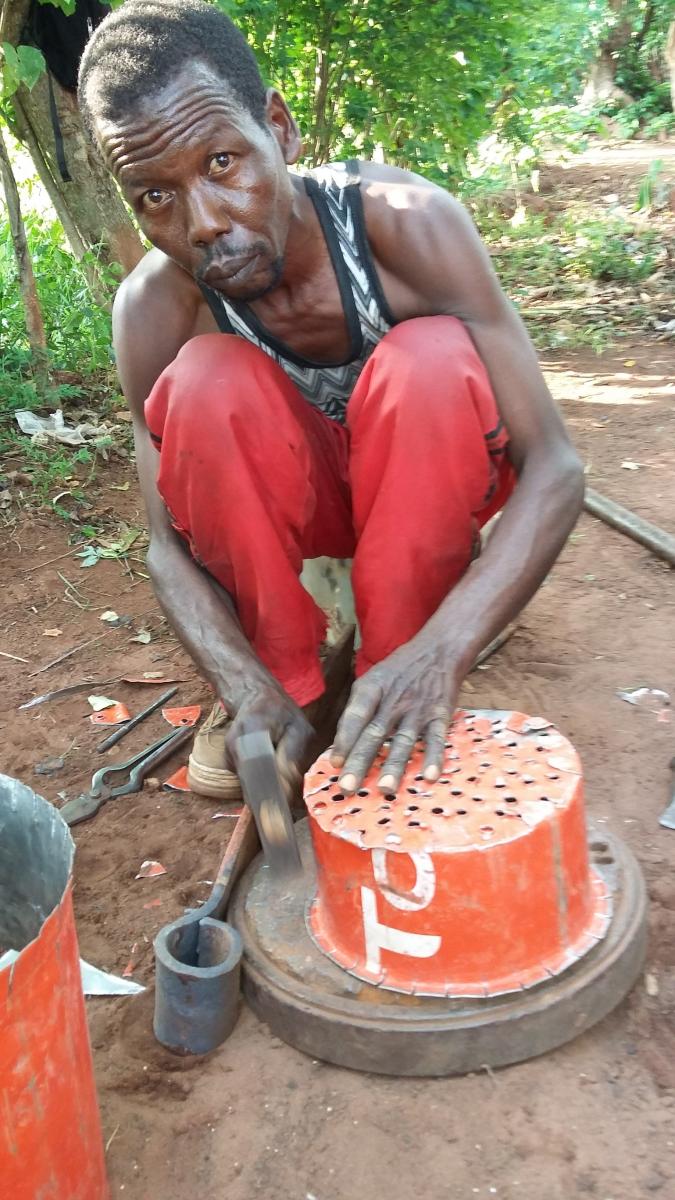
Missionnaires et forgerons: l'union fait la force!
Julie CLAASSENS | 28/09/2016
Un subside d’un montant de 19.000 euros a été attribué par le programme EDU-MOSU à la Congrégation des missionnaires Pères de Scheut de Gemena, afin d’appuyer la filière informelle de formation d’artisans forgerons dans la province du Sud-Ubangi. Vu que les opportunités d’emplois sont très limitées dans le secteur formel, il est apparu important à l’équipe EDU-MOSU d’adapter son approche et d’appuyer activement le développement de filières informelles. Au départ, un humanitaire belge ayant séjourné à Gemena a contacté la CTB en lui signalant un groupe de forgerons motivés pour s’organiser, afin de renforcer leurs capacités et la qualité de leurs productions. Notamment de foyers améliorés permettant d’économiser le bois ou le charbon de bois. Le programme EDU-MOSU a saisi cette opportunité pour appuyer des artisans du secteur privé non formel dispensant une formation basée sur la relation entre un artisan formateur et des apprentis. Parmi ces artisans forgerons, plusieurs métiers ont été distingués : la forge proprement dite, mais également la fonderie, la ferronnerie et la construction métallique. Les artisans étant déjà en contact avec les missionnaires, c’est à cette structure bien reconnue et solide que le subside a été attribué. Il revient aux missionnaires de préparer les activités nécessaires à la structuration des artisans en une association reconnue officiellement ainsi qu' à l'organisation de formations en identifiant les artisans les plus aptes à devenir des formateurs ou des apprentis. De son côté le programme EDU-MOSU va fournir un outillage de qualité tant aux artisans formateurs afin de les mettre dans de bonnes conditions qu’aux apprentis ayant réussi le parcours de formation afin de les aider dans leur insertion socio-professionnelle. Il est également prévu de relever le niveau de savoir-faire des formateurs en organisant des entraînements. A cet effet et pour soutenir d’une manière globale l'aquisition de compétences, le programme EDU-MOSU travaille en synergie avec une autre intervention de la Coopération Belge, le PRECOB, dont l’objectif est le renforcement des capacités. Le PRECOB apportera son appui pour les questions d'appui technique et organisationnel par la mobilisation d’expertises. Le PRECOB apportera également un appui méthodologique pour organiser l’instruction des stagiaires et aider à définir les programmes d’éducation. A terme, si cette première expérience se déroule bien et donne de bons résultats, cette approche pourra être développée, adaptée à d’autres secteurs professionnels et répliquée dans d’autres provinces de la RDC.
-
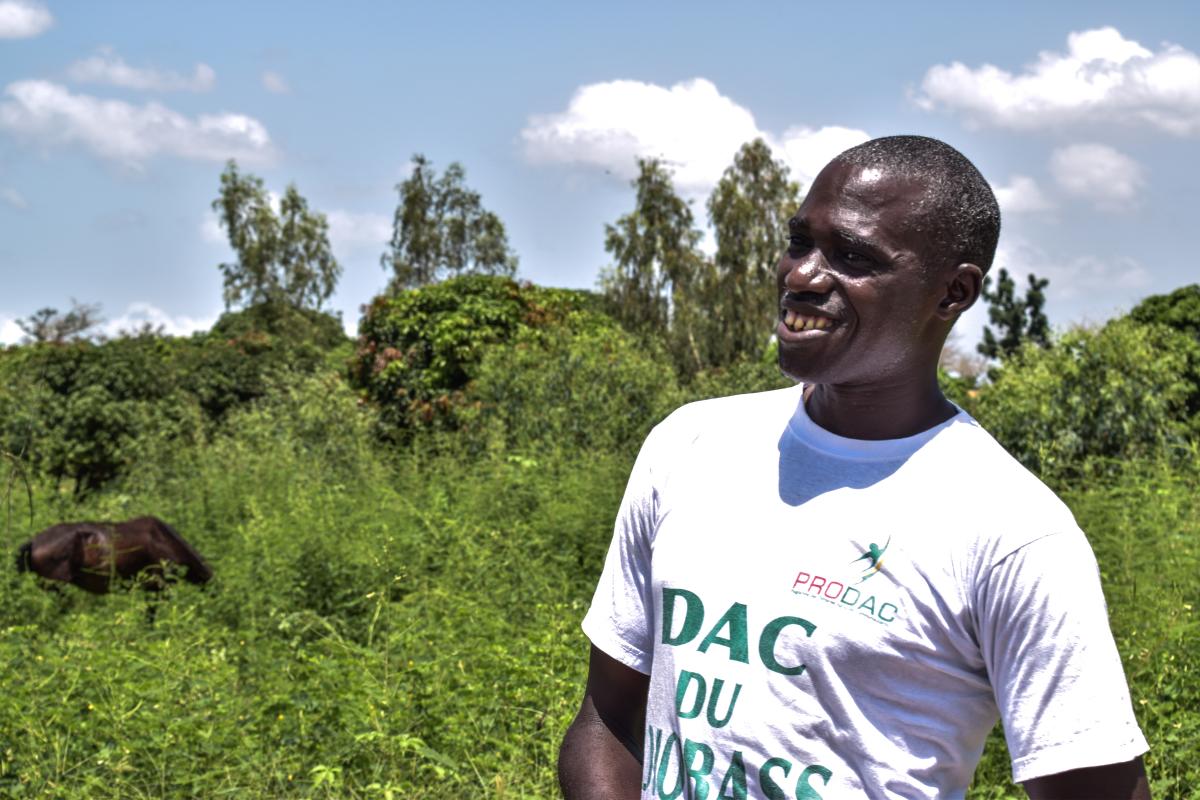
Finalement de l'eau dans les puits de Notto (Thiès)
Marcella PASOTTI | 28/09/2016
Depuis les années 60, la vallée de Diobass, située dans la région de Thiès, a connu des longues périodes de sécheresse avec comme conséquence majeure une baisse progressive de la nappe phréatique. Un temps riche en cours d’eaux, la vallée se retrouve aujourd’hui en carence de ressources hydriques, ce qui affecte fortement les populations de la zone qui vivent essentiellement d’agriculture. Ndiaga Diouf est un agriculteur du village de Notto Diobass et conseiller municipal dans la commune. Il explique que dans son village, comme dans toute la vallée, la principale activité économique est l’agriculture mais que les populations sont très découragées car elles n’arrivent pas à s’approvisionner en eau. « Je connais quelqu’un ici qui avait creusé un puit jusqu’à 30 m de profondeur sans trouver de l’eau… Moi-même j’ai un puit dans mon champ, construit il y a 15 ans, qui n’avait jamais eu de l’eau. » En 2015 BARVAFOR a réalisé quatre barrages dans la vallée de Diobass, suite à la requête introduite par la marie de Notto, dont Ndiaga Diouf fait partie. Trois digues semi-filtrantes consentent de ralentir le cours des eaux de ruissellement permettant à l’eau de s’infiltrer dans le terrain faisant ainsi remonter le niveau de la nappe phréatique. En outre, une digue de retenue, construite dans le village de Hanène, permet de stocker l’eau pluviale qui pourra ensuite être utilisée pour réaliser deux cycles agricoles durant la saison sèche, donnant ainsi à la population la possibilité de cultiver toute l’année. « Après seulement un an de la réalisation du barrage j’ai déjà de l’eau dans mon puit ! Je n’avais jamais eu de l’eau et maintenant j’en trouve à seulement 10m de profondeur. Avant je cultivais simplement de la manioc. Maintenant je peux faire du maraichage près de mon puit car c’est beaucoup plus rentable, et je continue à cultiver de la manioc ailleurs. »
-
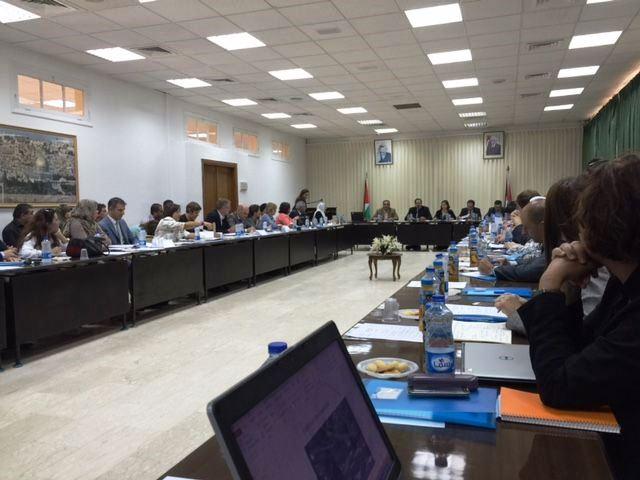
Education partners and policy makers meet in Ramallah at the Education Sector Working Group*
Eva MORRE | 27/09/2016
Ramallah - On 21 September 2016 the third Education Sector Working Group (ESWG) of the year took place in Ramallah at the Ministry of Education and Higher Education (MoEHE). This Working Group brings together key education stakeholders in the Palestinian Territory such as senior officials of the MoEHE, local and international civil society and development partners. His Excellency the Minister of Education and Higher Education, Dr. Sabri Saidam, updated the Working Group on recent developments made such as the curriculum reform, the new “Tawjihi” system that is being implemented in the West Bank and Gaza and the inclusion of Technical and Vocational Training and Education (TVET) modules in grades from 7th to 9th in 158 schools since the beginning of the school year. The Minister stated that “We hope to include more schools in the future, but this will happen gradually. The schools need to be equipped and more teachers need to receive the appropriate training.” Furthermore, he also referred to steps leading towards the approval of the new education law, to the situation of Education in East Jerusalem, and to the intention of making pre-school education compulsory. His Excellency expressed his gratitude for all the progress achieved and thanked the “education family for its continuous support.” Mrs. Florence Duvieusart, Consul and Head of Development Cooperation at the Consulate General of Belgium, speaking on behalf of the Joint Financial Partners (JFPs) and as co-chair of the Education Sector Working Group, mentioned the recent school visits in Gaza and stressed the importance of the M&E report. She highlighted "the revitalization of the Higher Council for TVET as a crucial and promising breakthrough in the concerted efforts to upgrade and upscale Vocational education" and the low illiteracy rate in the Palestinian Territories. Finally, she mentioned the significant progress obtained both at primary and at secondary level in terms of providing qualified teachers, while stressing the importance for further efforts on student centered learning and the use of educational resources.UNESCO, as the technical advisor to the Education Sector Working Group, commended the MoEHE for its effective contribution to the preparation of the Government’s National Policy Agenda setting out the vision for Palestine over the period 2017-2022. UNESCO Representative to Palestine, Dr. Lodovico Folin Calabi, reiterated that “the Education Sector Working Group is the natural platform for discussing and designing the most updated policies needed for ensuring inclusive and equitable quality education for all Palestinian children and youth”. During the break, the Ministry of Education and Higher Education together with the European Union have organized an event for the International Day of Peace. A thousand Palestinian children released white pigeons and balloons from the courtyard of the Ministry of Education marked with inscriptions reading “We want to live in peace” into the air. Afterwards, the MoEHE presented the Monitoring and Evaluation report from school districts and the indicators from East-Jerusalem schools. The event was closed by updates from the Technical Working Groups on progress made in the past three months. In preparation of the ESWG, representatives of the Ministry, UNESCO and the main partners in the education sector, had visited on Monday 19 September three different schools in Gaza, implementing TVET, inclusive education, and special needs education programmes and located in Access Restricted Area.The Education Sector Working Group is held every three months to assess and discuss achievements, challenges and ways forward in the education sector, also in a view of a better coordination of international aid cooperation towards the advancement of Education in Palestine. The MoEHE’s regular meetings with the donor community are prepared for and coordinated by Dr. Sakeena Elayan, the academic advisor of the Minister of Education and Higher Education. *This article is based on a press release from UNESCO Palestine.
-

A Short Movie on Gaza's TVET week
Eva MORRE | 22/09/2016
In the beginning of the year, a TVET week has been organised by the Belgian Development Agency (BTC), the EU and GIZ. The week-long event has promoted technical and vocational education and training (TVET) in Gaza. On the last day of the week we organised a Career Day to bring the graduates from the technical and vocational field in direct contact with potential employers from the private sector, and thanks to this event different students got hired. The main goals and most important outcomes of the event ‘Transforming Skills into Work’ have been captured in a short video. Enjoy!
-
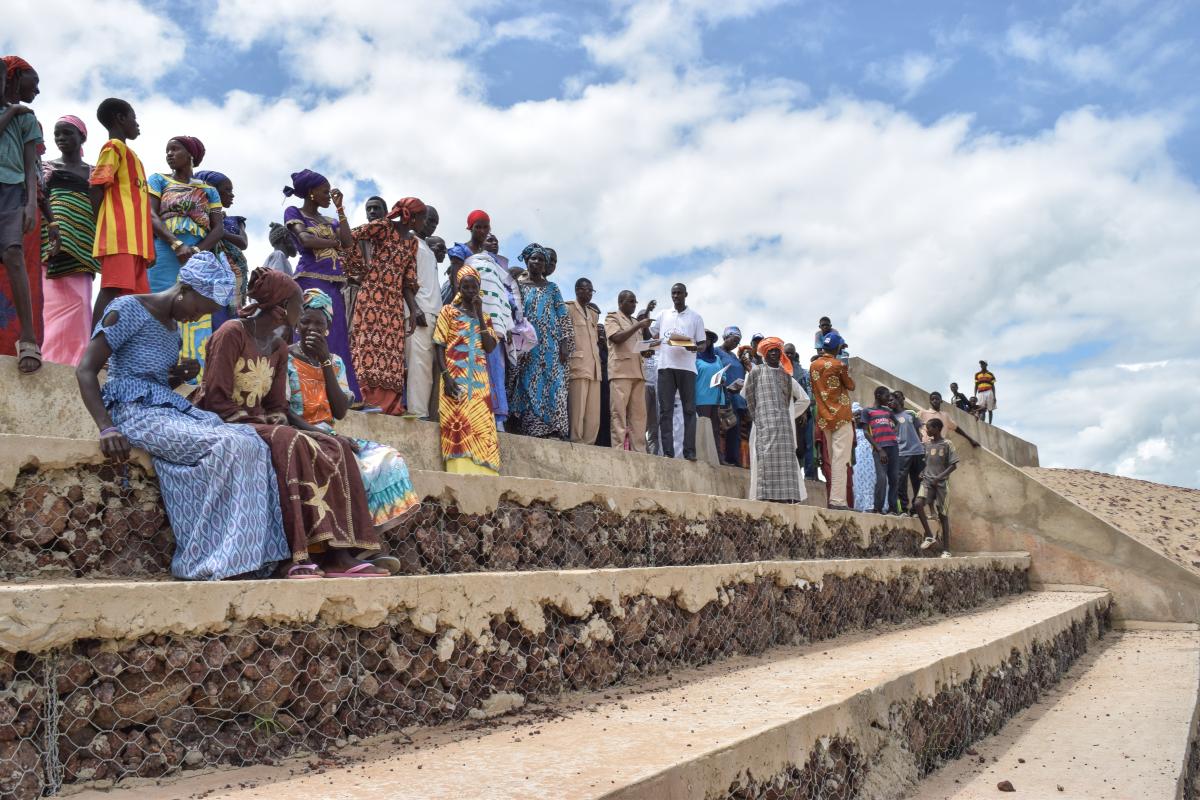
Visite officielle du Gouverneur de Kaffrine
Marcella PASOTTI | 21/09/2016
Le 31 aout 2016 le Gouverneur de la région de Kaffrine et le Comité Régional de Suivi ont effectué une visite de terrain à Kaffrine avec le projet BARVAFOR pour apprécier l’état de mise en œuvre du projet dans la région. Les participants ont visité les sites de Ndiayène Lour et Coumbidia Socé, ils ont constaté avec satisfaction l’achèvement des travaux à 100% et la satisfaction des populations. Dans ces deux villages le projet a réalisé deux digues de retenue suite à la requête introduite par les maires de ces localités et leur population. Dans la région de Kaffrine, BARVAFOR a également réalisé 04 autres digues de retenue et 02 rééquipements de forage. Pour plus d’images, visitez notre gallérie photo.
-
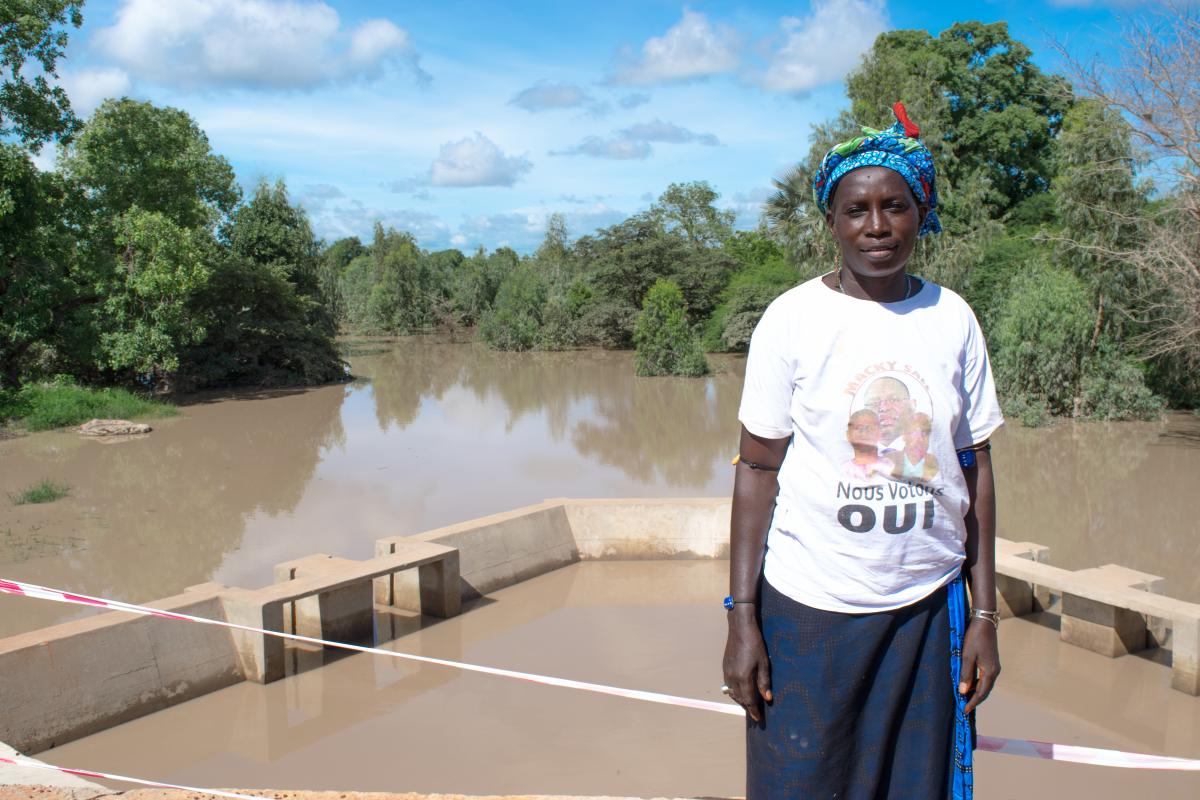
Saison des pluies 2016 au Sénégal
Marcella PASOTTI | 20/09/2016
La saison des pluies continue au Sénégal et les agriculteurs sont maintenant très occupés dans les travaux agricoles. Même si cette année les précipitations n’ont pas encore été consistantes, les infrastructures de retenue de BARVAFOR ont déjà commencé à jouer leur rôle de stockage d’eau pluviale. A Ndiawara dans la région de Kaffrine, Rocky Sanga, présidente du comité de gestion en charge de la digue, nous a promené sur le barrage et montré avec satisfaction l’eau que le barrage commence à stocker. Celle-ci permettra à Rocky et aux agriculteurs des villages autour de l’ouvrage de continuer leurs activités même après l’hivernage, leur donnant ainsi une source de revenue pour les mois à venir. Pour plus de photos des ouvrages BARVAFOR à Kaffrine, n’hésitez pas à visiter notre gallérie photo.
